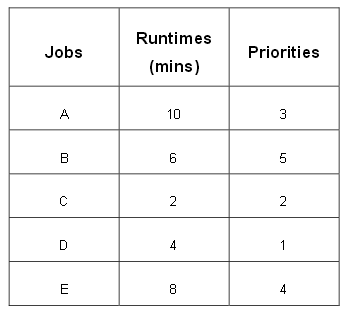Question
1.Consider the following scenario. The jobs arrived approximately at the same time and the larger number represents the higher priority. Process switching overhead is negligible
1.Consider the following scenario. The jobs arrived approximately at the same time and the larger number represents the higher priority. Process switching overhead is negligible

For each process scheduling algorithm, determine the average turnaround time and the average waiting time. Hit: draw a Gantt chart for the execution:
a.First Come First Server (FCFS)
b.Priority Scheduling
c.Shortest Job First (SJF)
d.Round Robin Scheduling with a quantum length of 2 minutes
2.Assume you have the following jobs to execute with one processor, with the jobs arriving in the order listed here:
i T(pi)
0 80
1 20
2 10
3 20
4 50
a.If a system uses FCFS scheduling, create a Gantt chart illustrating the execution of these processes?
b.What is the turnaround time for process p3?
c.What is the average wait time for the processes?
3.What scheduling policy will you use for each of the following cases? Explain your reasons for choosing them.
a.The processes arrive at large time intervals:
b.The systems efficiency is measured by the percentage of jobs completed.
c.All the processes take almost equal amounts of time to complete.
Runtimes Jobs Priorities (mins) 10
Step by Step Solution
There are 3 Steps involved in it
Step: 1

Get Instant Access to Expert-Tailored Solutions
See step-by-step solutions with expert insights and AI powered tools for academic success
Step: 2

Step: 3

Ace Your Homework with AI
Get the answers you need in no time with our AI-driven, step-by-step assistance
Get Started


